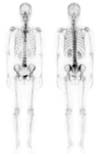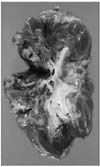Abstract
We report a case of a metastatic renal tumor secondary to breast cancer 9 years postmastectomy. This is the first case report of solitary renal metastasis from breast cancer with no other evidence of metastasis. A 47-year-old woman underwent a modified radical mastectomy and 6 cycles of CEF chemotherapy (Cyclophosphamide, Epirubicin, 5-FU) for cancer of the left breast. She was followed closely, but no recurrence or metastases were detected on either a physical or radiological examination. 9 years later, on a routine follow-up examination for metastatic breast cancer, abdomen ultrasound revealed a solid mass (4cm in diameter) in the upper portion of the right kidney. Computed tomography (CT) was used to further evaluate the solitary renal mass, which had become moderately enhanced. No regional lymph node, visceral or pulmonary metastases were found. A radionuclide bone scan confirmed no bony involvement. A laparoscopic radical nephrectomy was performed for a right renal tumor. The histopathological features were identical to those for cancer of the right breast. The patient was treated with adjuvant combination chemotherapy (docetaxel and adriamycin), and is still alive 9 months after a right radical nephrectomy, with no evidence of recurrence.
Figures and Tables
Fig. 1
Whole body bone scan showing no bony metastasis. High uptake of the L5-S1 lesion, suggestive of a degenerative joint disease.

Fig. 3
Computed tomography (CT) scan demonstrating a heterogeneous enhanced mass in the upper portion of the right kidney.

Fig. 4
Gross findings of the renal mass, revealing a yellow to brown colored, encapsulated mass, with a focal hemorrhage.

References
1. Bracken RB, Chica G, Johnson DE, Luna M. Secondary renal neoplasms: an autopsy study. South Med J. 1979. 72:806–807.
2. Takehara K, Koga S, Nishikido M, Kanetake H, Hayashi T, Hara S, et al. Breast cancer metastatic to the kidney. Anticancer Res. 1999. 19:5571–5573.
3. Wagle DG, Moore RH, Murphy GP. Secondary carcinomas of the kidney. J Urol. 1975. 114:30–32.
4. Pagani JJ. Solid renal mass in the cancer patient: second primary renal cell carcinoma versus renal metastasis. J Comput Assist Tomogr. 1983. 7:444–448.
5. Choyke PL, White EM, Zeman RK, Jaffe MH, Clark LR. Renal metastases: clinicopathologic and radiologic correlation. Radiology. 1987. 162:359–363.
6. Hietala SO, Wahlqvist L. Metastatic tumors to the kidney. A postmortem, radiologic and clinical investigation. Acta Radiol Diagn. 1982. 23:585–591.
7. Bhatt GM, Bernardino ME, Graham SD Jr. CT diagnosis of renal metastases. J Comput Assist Tomogr. 1983. 7:1032–1034.
8. Giashuddin S, Cangiarella J, Elgert P, Levine PH. Metastases to the kidney: eleven cases diagnosed by aspiration biopsy with histological correlation. Diagn Cytopathol. 2005. 32:325–329.
9. Ridlon HC, McAdams GB. Breast carcinoma metastatic to kidney. J Urol. 1967. 98:328–330.




 PDF
PDF ePub
ePub Citation
Citation Print
Print






 XML Download
XML Download